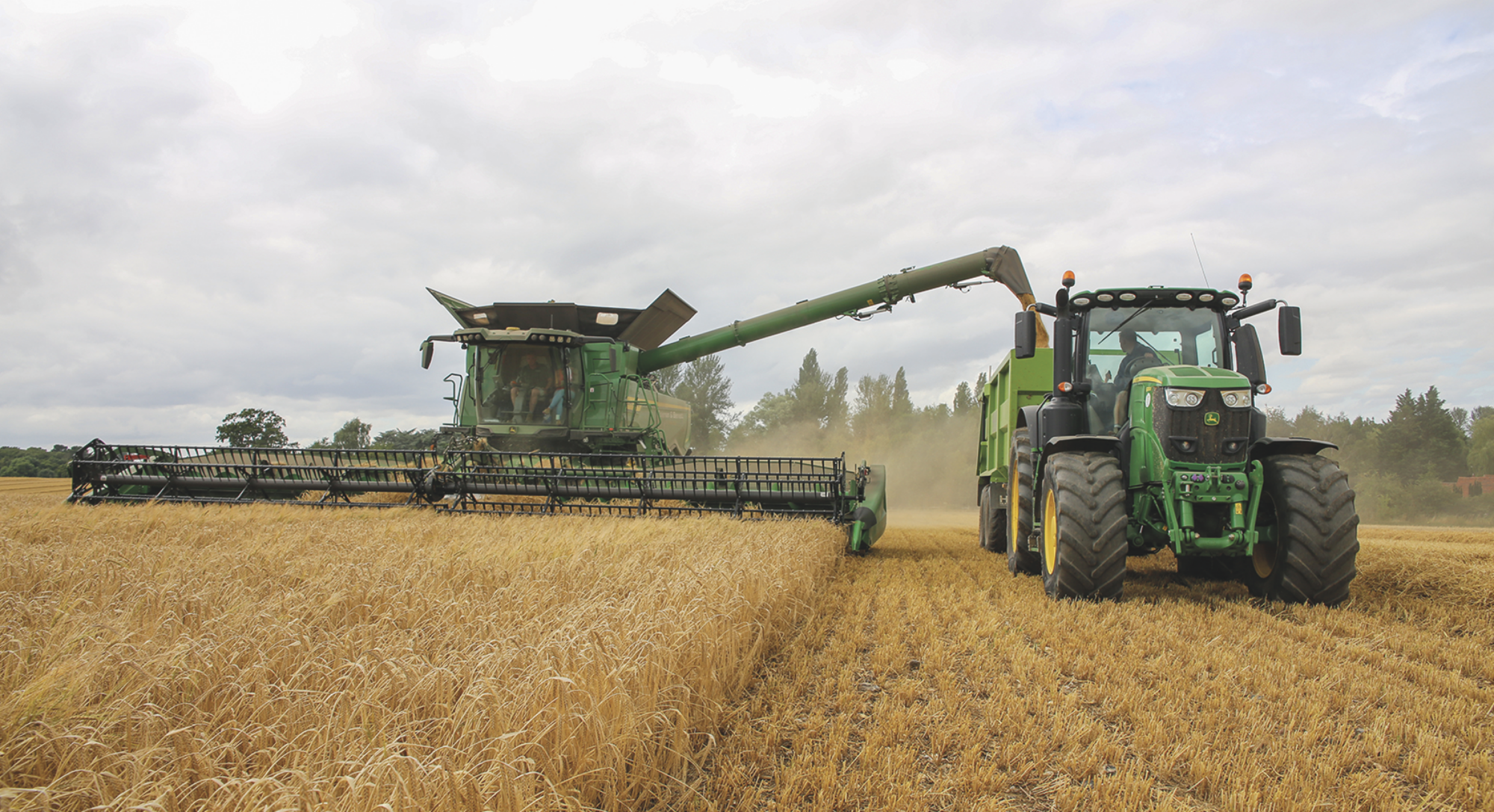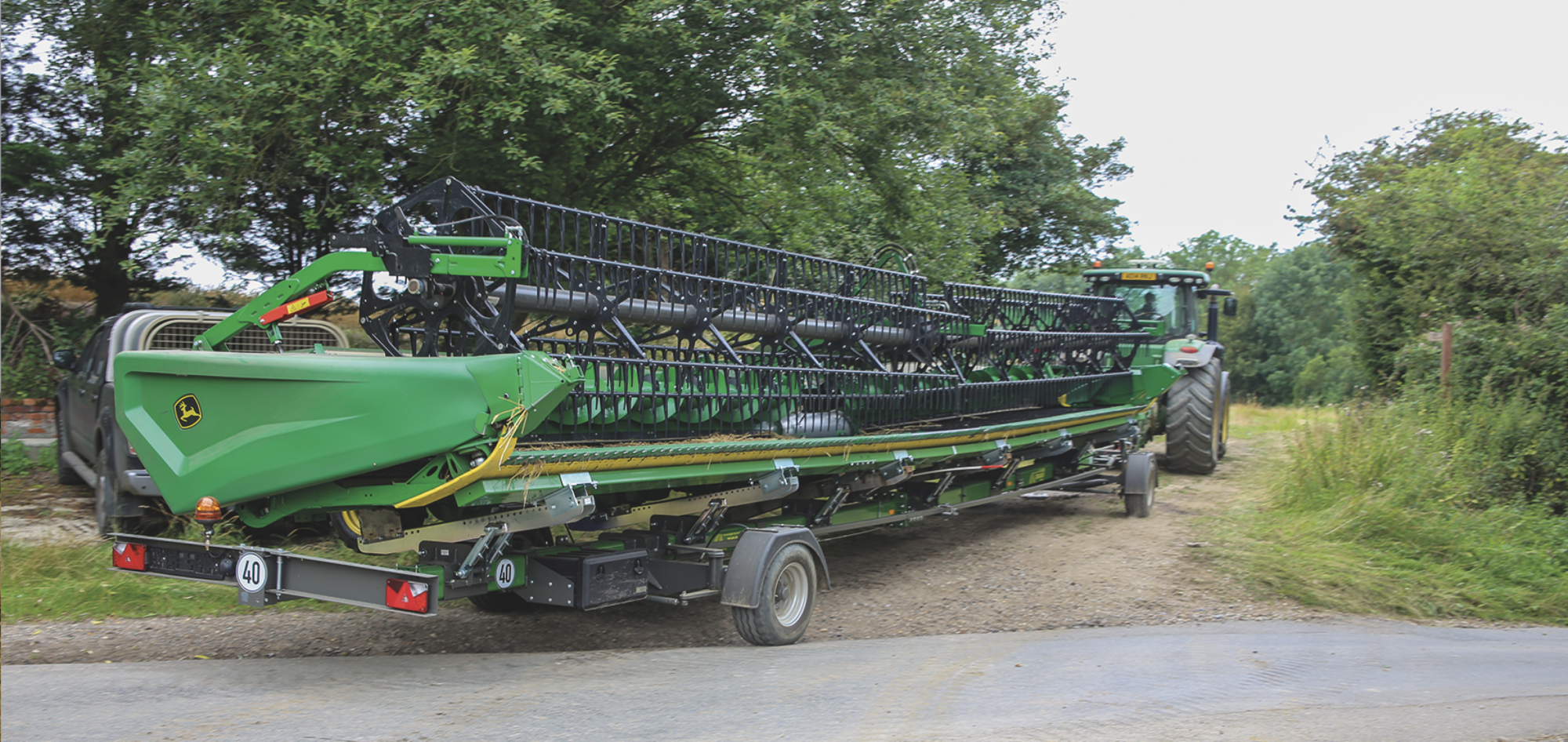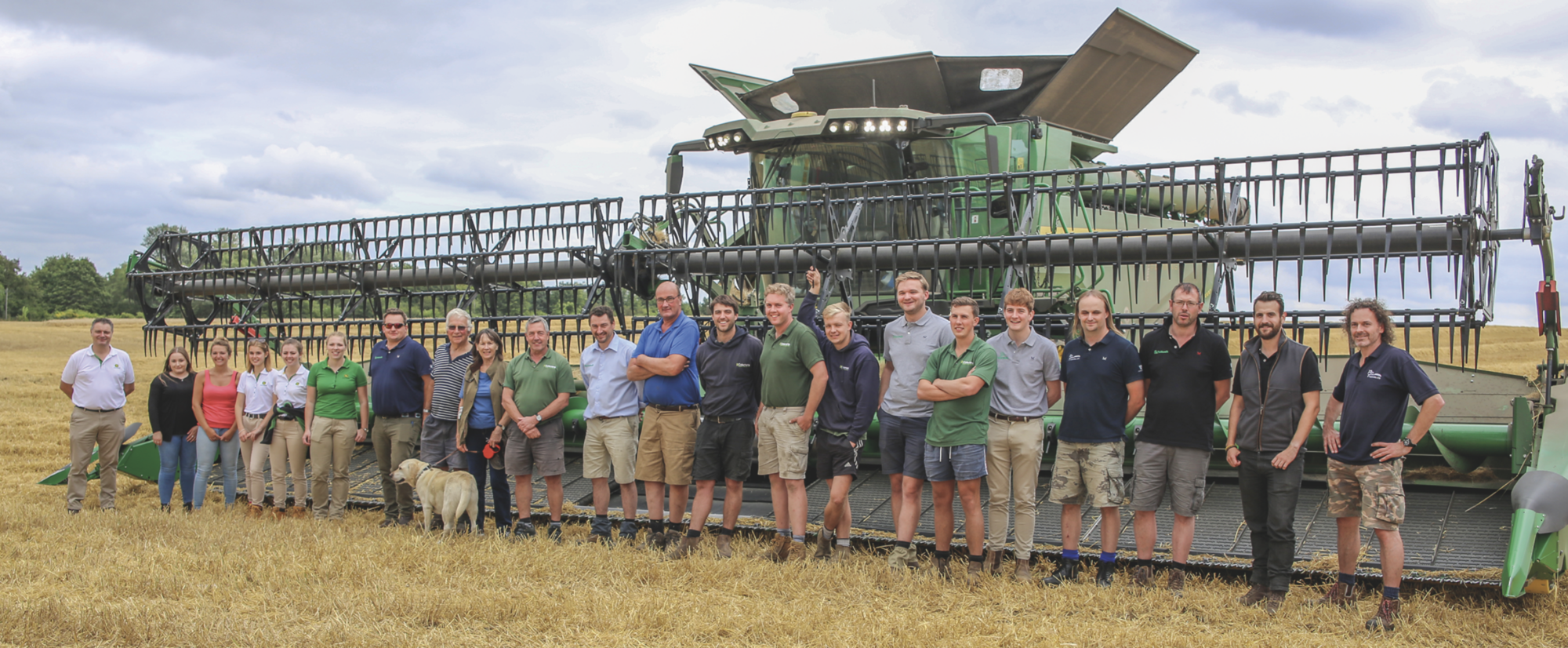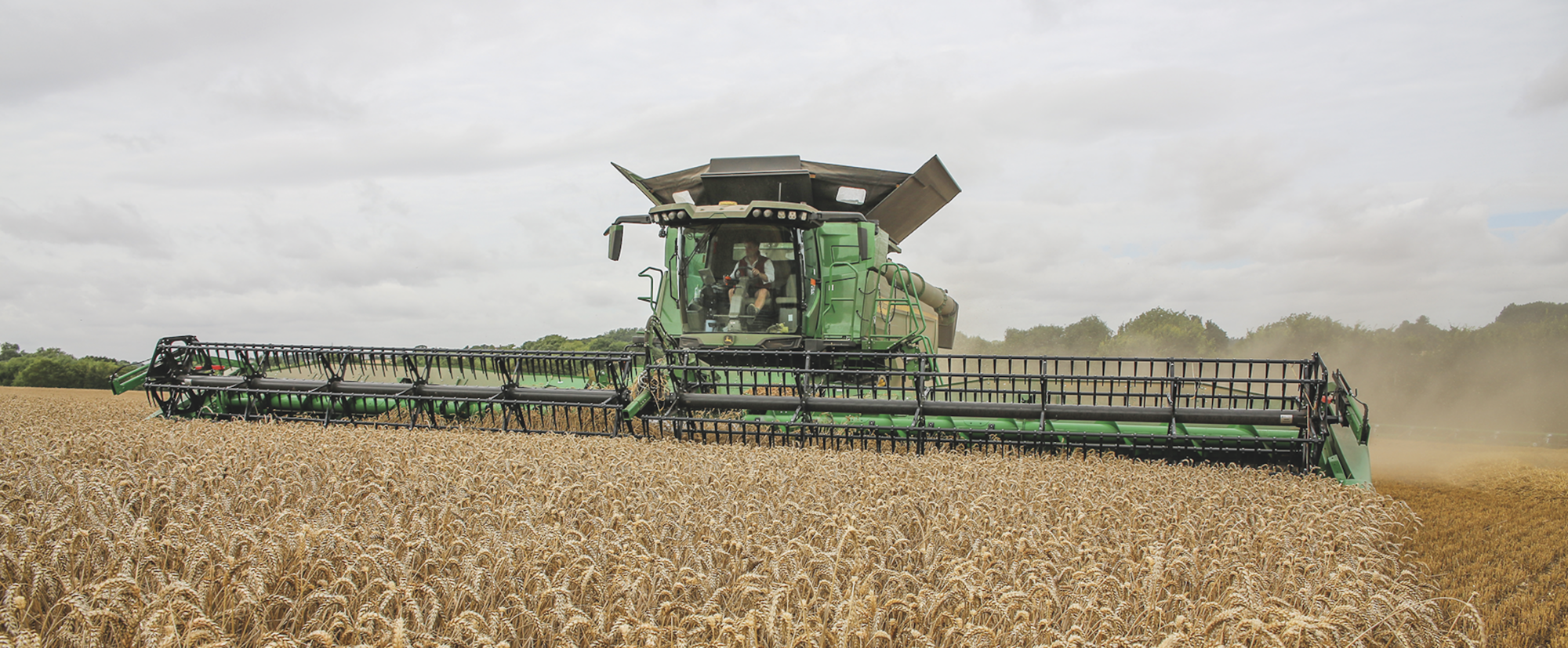New combine meets expectations in difficult harvest
25th September 2021
Two Essex farmers who each invested in John Deere X9 high-capacity combines for this harvest have been delighted with the performance. David Williams reports.

Both combines were supplied by main dealer Tuckwells, and territory sales manager for the Dunmow and Rayleigh depots, Tim Thornton said interest in the new range flagship continues to grow. “We have received very positive feedback from both users, including daily work rates equivalent to the combined output of the two combines each of them replaced.
“Continuous damp working conditions and large volumes of straw made this harvest a challenge, but the John Deere HDX Hinged Draper header coped well in all crops and supplied an even feed to the rotors to optimise output and minimise losses.
“We received a lot more enquiries this harvest from farmers and contractors considering buying an X9 to replace their current John Deere combines as well as other brands, so we have already decided to add one to our demonstration fleet for next harvest.”
Simpler system
Trading as JR & EH Nott, and based at Ovington Hall on the Essex/Suffolk border, James Nott replaced his two John Deere S690 combines equipped with 635R 35ft headers, with one X9- 1100 with an HD45X 45ft header. The X9-1100 is powered by a 13.6-litre 6-cyl engine producing up to 690hp between 1,700–1,900rpm, but in tough conditions when the engine revs are pulled down under load, maximum 3,000Nm torque is achieved at 1,500rpm, so operators can maximise work rates in difficult working conditions without fear of blockages.
James tried the new X9 combine on his farm last harvest before placing his order. “I think the X9 is remarkable,” he said. “A competitor’s machine with a lot more power was also considered, but we preferred the John Deere. One of the best features is the HDX header, which is a massive step up from those on our previous machines. Three sections move independently for accurate contour following and the table can be tilted forward to push the knife under laid crops and ensure nothing is missed. Cross conveyors maintain an even feed to the threshing system. The combine easily harvests 70ha of cereals per day, including moving between fields and without working late, so if we are under pressure and need to achieve 85ha or even more then this won’t be a problem. Average losses are well under one per cent which is incredibly low.”
Matches combined output
“The single X9 matches the combined output of our two previous machines, and the whole operation is easier to manage,” continued James. “Corn cart drivers head straight to the combine so that they are nearby as soon as the tank is full, and they don’t waste time travelling to the second machine just to top up the trailers before heading to the store. Moving between fields is more efficient too. When two combines are used – one usually stays to finish a field while the other travels to open up the next one, but both need corn trailers with them, and tractors and people are needed to escort them, and to help remove, transport and reattach the headers. There is also twice the daily maintenance. Running one machine is more efficient and saves time.”

A Ziegler header trailer was purchased from importer Abrey Agricultural. Four-wheel steering means it accurately follows the wheel tracks of the towing vehicle and James Nott commented that it allows narrow gateways to be negotiated with ease.
Range of crops
Much of the land is contract-farmed. Crops include milling and feed wheats, malting and feed barleys, oilseed rape, beans, and peas this year for the first time in two generations farming the land. Spring oats are also grown, and sugar beet and maize are part of the rotation.
“The previous John Deere S690 combines were great in minority crops and very gentle on grain for seed and malting, but we wanted a simpler life while maintaining the productivity to make the most of available weather windows to complete harvest on time,” continued James. “As soon as harvesting started this year, it was obvious that the new system was more efficient. Time saved chasing two combines around the field means we have reduced the trailer size from 20t to 14t. The larger trailers couldn’t hold two full tanks of grain from the X9 anyway, so it’s more efficient to empty a full tank once, and head to the store. Using smaller trailers is working well, and it’s safer too.”
Challenging season
When Farmers Guide visited the farm, the X9 was harvesting wheat at 65t/hr at 6.5kph, but conditions were damp and the bushel weight was only 68kg. Despite challenging conditions this season, harvesting rates of 80–85tph have been typical, but in wheat yielding 9t/ha this increased to 105tph. Losses are negligible, and James commented that a field drilled with oilseed rape following early harvested winter barley had emerged quickly, with no barley volunteers.
Confidence in dealer
James said that the change from running two proven combines to the single X9 hadn’t worried him. “Tuckwells’ back-up is superb and the team sorts any issues as soon as they occur. John Deere and Tuckwells are both excellent, and I am confident that if anything does go wrong that prevents us working then there will already be a contingency plan in place.”
Most machinery is supplied by Tuckwells, and the eight-tractor fleet includes six John Deeres, a large tracked tractor of another brand, plus a specialist slurry applicator. All the tractors and the combine are monitored through the John Deere Operations Center app – which James describes as a great management tool.
“John Deere seems to get things right, and we bought one of the latest 8RX tractors earlier this year which has proved a real game changer. It was chosen for drilling, but it is proving so versatile that it is preferred now for almost all the top-work.
“The Tuckwells team is always interested in what we are doing, and we deal mainly with sales representative Steve Buckett and the service manager Glen Sweeting. Roger Gregory has serviced our combines for the past 30 years and is never phased by problems – he just gets on and fixes them.”
Impressive design
Combine operator Steven Mynott is also impressed by the combine’s design and describes its performance as fantastic. “I usually set up the combine using John Deere’s default settings for the crop, then experiment with the optimisation. The design makes it easy to achieve high work rates with minimal losses and the sample quality is excellent.”
Steven said the HDX header’s contour following accuracy makes his job much easier. “On the third headland pass when travelling across the tramlines there is usually no need to reduce the speed as the header floats so well. It hugs the ground, and in laid crops just tilting the header forward to push the knife down under the crop ensures nothing is left on the ground.”
Double knife sections achieve an excellent cut even in dense straw in damp conditions, and Steven said that he often hasn’t realised when blade sections have been damaged until checking the combine the next morning as the cutting performance remains so good.
“Daily maintenance is quick and easy, and the engine bay remains clear of dust and chaff. I cleaned the engine air filter for the first time after harvesting 500ha, and although a small amount of dust was present it definitely didn’t need cleaning. For the first few days I opened the cooling pack door to check and clean it, but it was always spotless so I don’t check it as often now.”
The X9’s wheelbase is slightly longer than the S690’s, but Steve said manoeuvrability is just as good. He says the cab is quiet and comfortable and the controls are easy to use. His criticisms are minor, and include the unloading auger design as even when folded for transport it sticks out a long way at the rear, and the shape of the header back- plate which accumulates barley awns until they restrict the operator’s view of the central section of the knife.
Multiple benefits
“We saved capital expenditure by replacing two combines with one, but we have also reduced our fuel and maintenance costs,” stressed James. “Our two S690 combines consumed approximately 750 litres of diesel each per day, and the X9 uses approximately 800 litres but does twice the amount of work. The X9-1100’s engine usually operates between 1,700–1,900rpm whereas the S690s operated at 2,100, but the fuel economy isn’t only due to the new engine – the whole combine design is very clever and efficient.
“We have also reduced our labour requirement as only one combine operator is needed and we use one less grain cart, but for me the biggest advantage is that we achieve work rates similar to before while the whole operation is so much easier to manage.”
Running one combine an attractive option
An X9-1000 was chosen to replace two John Deere S680 combines with 30ft headers by Dunmow, Essex-based Coleman & Bennett.
In 2016, neighbouring farming operations owned by the Coleman and Bennett families merged their cultivating and drilling activities, and in 2017 all other farm operations except spraying were also combined. Approximately 1,700ha is farmed on land owned, rented and on FBTs, and approximately 265ha of additional contract cultivations and drilling are carried out for other farms.
The two S680s were due for updating last year at the same time as one of the long-term combine operators was due to retire, so the opportunity to change to one combine – reducing the labour requirement – was an attractive prospect. “When it was suggested that one X9 could match the output of our two previous combines, it became a simple decision,” explained Jack Coleman.
“We have always used John Deere tractors and combines on our farm, and a CTS twin-rotor combine was bought from Tuckwells in 2011, then when we merged the farming operations in 2017, each farm bought an S680 with a 30ft header and the two were then run and maintained as a pair.”

A demonstration day organised by Tuckwells on land farmed by Coleman & Bennett was attended by teams from John Deere, Tuckwells and the farm.
Dealer team is like family
The tractor fleet includes six John Deeres, all supplied by Tuckwells. “The dealer is key to everything we do, and we regard the Dunmow depot team as part of our family,” he added. “Originally we considered replacing the two S680s with two S690s, but when we heard that the X9 was coming we decided to wait. We didn’t see one working before we placed our order but had faith in John Deere and Tuckwells, and we also asked the opinion of James Nott as we knew he had tried it on his farm.
“Simpler logistics with one combine, one header trailer, one driver and one bowser appealed, so we ordered an X9-1000 which had been one of the trial machines during 2020.”
Performance without losses
As soon as the X9 arrived, its performance impressed both families. “Conditions have been challenging with a lot of unripe grains in the barley,” explained Jack. “However, the HDX header achieves even, heads-first feeding for optimum threshing performance and it had no problem picking up laid crops at 7.5kph. Oilseed rape yielding 2.5t/ha was harvested at 7kph with minimal losses at a work rate of 8ha/hr – which was more than we could have done with the two S680s together.
“We changed from two combines with a combined cutting width of 60ft, to the X9 with 40ft, and while we struggled to believe the new combine would actually harvest as much in a day, it is doing it with no problems.”
Opportunities to work are increased. “We can definitely harvest later into the evening with the X9,” continued Jack. “The HDX header allows harvesting to continue after other combines would have stopped, and its ability to pick up the crop then feed it heads first evenly to the intake elevator is impressive and is a key factor in getting the best out of the machine.”
Grain losses average well below one per cent, stressed Jack, and in winter barley yielding 7.2t/ ha harvested at 6.5–7.0kph at the start of the season, total losses were just 0.2 per cent.
Significant cost savings
Running one combine instead of two is reducing the farm’s fuel costs, as similar daily work rates are achieved with less total fuel consumption.
Jack’s father Michael said significant cost savings are also achieved through having only one combine operator – equivalent to the typical gross margin from 40ha of cereal crops.
“We were nervous moving from two combines to one, but there were opportunities for significant cost savings,” Michael continued. “If we have an exceptionally difficult season and struggle, then we always have the option to hire an additional combine from several neighbours. Challenging weather has created difficult working conditions this harvest, but the X9 is coping well.”
Pleasure to operate
Operator Alex Shutes joined Coleman and Bennett last year having previously operated a competitor brand combine elsewhere, and he described the cab as excellent, and said John Deere’s machine management systems make it easy to get the best from the machine.
“The work rate is phenomenal and the header seems to suck all crops in heads first, whatever the conditions.”
Trust in the dealer
“We have a fantastic relationship with the Tuckwells team and just can’t fault them,” concluded Michael. “We wouldn’t have had the confidence to rely on only one combine if we didn’t have that much trust in our dealer, and if problems occur then we know we will be back working quickly.”

The performance of the HD45X Hinged Draper header is described as excellent by James Nott. Its ground-hugging ability ensures laid barley is picked up effectively and 1.2m deep rubber cross belts feed crops head-first into the combine for optimum threshing performance.
